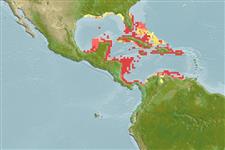Environment: milieu / climate zone / djupintervall / distribution range
Ekologi
marina revassocierade; djupintervall 0 - 9 m. Subtropical; 33°N - 25°S, 95°W - 65°W
Western Atlantic: Bermuda, southern Florida (USA), Bahamas, and Yucatan (Mexico) to the Antilles (Ref. 26340) and northern South America.
Size / Vikt / Age
Könsmognad: Lm ? range ? - ? cm
Max length : 102 cm TL hane/ej könsbestämd; (Ref. 7251)
Light brown to grayish brown, darker above, with pale spots (Ref. 26938).
Body shape (shape guide): eel-like.
Commonly encountered swimming near the bottom in clear water from harbors to reefs. More common along continent and in grassy areas (Ref. 7251). Found in shallow areas to depths of 9 m. Feeds mainly on crabs. (Ref. 26938).
Life cycle and mating behavior
Könsmognad | Reproduktion | Lek | Ägg | Fecundity | Larver
Distinct pairing (Ref. 205).
Robins, C.R., R.M. Bailey, C.E. Bond, J.R. Brooker, E.A. Lachner, R.N. Lea and W.B. Scott, 1991. Common and scientific names of fishes from the United States and Canada. Am. Fish. Soc. Spec. Publ. (20):183 p. (Ref. 3814)
IUCN Red List Status (Ref. 130435: Version 2025-1)
Threat to humans
Harmless
Human uses
Verktyg
Special reports
Download XML
Internet-källor
Estimates based on models
Preferred temperature (Ref.
123201): 26.1 - 28.3, mean 27.5 °C (based on 435 cells).
Phylogenetic diversity index (Ref.
82804): PD
50 = 0.5005 [Uniqueness, from 0.5 = low to 2.0 = high].
Bayesian length-weight: a=0.00091 (0.00039 - 0.00215), b=2.99 (2.79 - 3.19), in cm total length, based on LWR estimates for this (Sub)family-body shape (Ref.
93245).
Trofisk nivå (Ref.
69278): 3.5 ±0.5 se; based on diet studies.
Resiliens (Ref.
120179): Mellan, lägsta populationsfördubblingstid 1,4-4,4 år (Preliminary K or Fecundity.).
Fishing Vulnerability (Ref.
59153): High vulnerability (61 of 100).
🛈
Nutrients (Ref.
124155): Calcium = 22.6 [9.9, 50.3] mg/100g; Iron = 0.489 [0.252, 0.990] mg/100g; Protein = 19.6 [17.3, 22.1] %; Omega3 = 0.13 [0.05, 0.36] g/100g; Selenium = 15.6 [7.4, 38.2] μg/100g; VitaminA = 28.2 [7.1, 106.3] μg/100g; Zinc = 0.643 [0.414, 1.011] mg/100g (wet weight);
